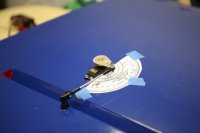Naughty Monkey
100cc
Oh, and not a nice trick with the video cover pic!!!!
Joe, great video. It is pretty much how I set up my multi servo surfaces. I may have missed it but when I set up my servos my end points in the radio are all exact. Say 120% for this discussion. I leave that end point there and do not adjust it. I will then use the turn buckle and change sub trim for "new center" till I get equal travel on full up and full down. Once I get that I zero sub trim and will use multiple different arms to try and get my sub trim as close to 0 as possible. I now use airwild unihubs to get that tuning even better. So now I will have my end points equal in the radio with slightly different subtrim values. By tuning for closer to 0 sub trim is usually good for a few extra degree's in surface deflection. I usually don't take the arm off but for checking for binding I will remove one of the surface control horn bolts and "eye up the hole" where the bolt should go to see if there is any change in balance. If there is then I will use the servo balance to fix it. With my JR brushless servos I found this to be the best because an amp meter does not work very well for checking binding.

Thank you Joe! I use the protractor to set my predetermined center but never thought of using it to set my control Horn height. I just measured to center and got close. In a short version I was only getting half way there to perfect servo geometry. It all makes sense now.
Nice Joe. You ever think about being a hand model?
Oh, and not a nice trick with the video cover pic!!!!
I was there! You made some killer flights with that plane!! It was a lot of fun to watch. Remember when it lost a wheel in the air and you hovered it while Kurt and someone else caught it so it wouldn't get torn up?
Learning a lot here. Thx Joe.
Joe, I tried a protractor once and found that method of using it painful. So I bought an incidence meter that can be used for checking throws. Full up and full down with anything in the middle. So I measure full up and full down and use the turn buckle to get even throws at the same end point travel. Using the post style control horns really help dial that in also. I measure to the 10th of a degree. I have had to change my end point 1 or 2% before but that is not common. Being an IMAC guy I measure for equal travel on all surfaces like aileron and elevator to make sure travel is almost exact. It usually is within a few 10th throughout the range of travel. I should do a video on how I do it. I'm always up for learning.
